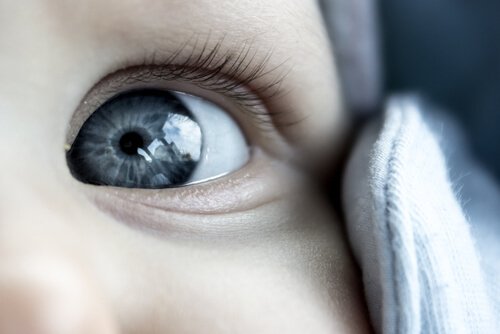How Do I Remove Rheum From My Baby's Eyes?

It’s important that you know the correct way to remove rheum from your baby’s eyes. This will prevent major complications and maintain your baby’s hygiene.
It’s normal for babies to have rheum when they wake up, since keeping their eyes closed for a long time will cause secretion to accumulate in the lacrimal gland.
However, there are other reasons why babies may develop rheum.
What is rheum?
Rheum is a thin secretion that occurs in the eyelid and lacrimal gland. Occasionally there can be more than usual and this can prevent babies from opening their eyes normally. It’s usually yellowish or whitish in color.
Causes of rheum
Rheum can occur for many reasons. These are some of the most common:
- When not blinking, tears accumulate and don’t come out through the drainage hole.
- Babies keep their eyes closed for long periods. Therefore, the sufficient quantity of water doesn’t evaporate and this leads to the formation of secretion.
- If they have a lot of rheum discharge, babies may have a blocked lagrimal gland, which will prevent them from draining their tears.
- Inflammation of the conjunctiva, allergies or foreign bodies.

Ways to remove rheum from your baby’s eyes
You should learn the best way to remove rheum from your baby’s eyes in order to maintain his or her hygiene, and avoid infections. Here are some tips:
- You shouldn’t remove rheum with your fingers or dry material.
- Use a sterile strip of gauze moistened with physiological saline. Wipe it from the lagrimal gland to the outside of the eye. Never in reverse.
- If the eyes are glued shut to excess secretion, moisturize them directly with ocular saline solution. Then apply the sterile gauze.
- It’s important not to use the same gauze in both eyes, since if there is infection in one eye it will be transmitted to the other.
- Another option is to use special wipes for cleaning the baby’s eyes.
- Don’t apply eyewash or eyedrops that the specialist hasn’t recommended.
- This cleaning can be done twice a day: in the morning when waking up, because that’s when rheum is most abundant, and after a bath.
Rheum caused by obstruction of the lacrimal gland
Lacrimal gland obstruction is a very common condition in newborns. This anomaly is known as stenosis of the nasolacrimal duct.
Because of the obstruction, tears don’t flow properly, which causes a yellowish, whitish or greenish secretion, and leads to abundant rheum.
This condition occurs because the fold of the mucosa isn’t partially or completely perforated. To remove rheum from your baby’s eyes which has been caused by this condition, you need to carefully follow the above recommendations.
You can also gently massage the inner corner of the eye and the base of the nose. By doing so, you stimulate the Hasner valve – a fold of the mucosa that isn’t perforated – and facilitate tear drainage.
This condition is temporary and may only be an issue during the baby’s first year. If abundant secretion persists, you should see a specialist.
“You shouldn’t remove your baby’s rheum with your fingers or a dry material”
Rheum caused by conjunctivitis
Conjunctivitis is an inflammation of the conjunctiva, a transparent membrane that covers the inside of the eyelids, causing abundant secretions of rheum in the child.

Symptoms of conjunctivitis in babies
If your baby has eyes which are glued shut, redness accompanied by abundant secretion and swelling, he or she may have conjunctivitis.
Causes of conjunctivitis
There are several factors that cause conjunctivitis in babies. For example:
- Virus: this is the most common cause. They have a cold along with redness, swelling of the eyes and a marked increase in the rheum.
- Bacteria: it’s caused by streptococcal and staphylococcal bacteria. It will manifest in the form of a thick, yellow discharge. The eyelids swell and tend to be glued shut when they awaken.
- Drops for newborns: also known as chemical conjunctivitis. Drops that are applied to newborns to prevent infection can cause irritation.
- Allergens: this is very rare in babies under one year old. If your child has red, watery eyes with rheum and rubs them a lot, he or she probably has an allergic reaction caused by an irritating agent such as dust, pollen or smoke.
Finally, avoid exposing your baby to these agents. In addition, follow the previous suggestions to remove rheum from your baby’s eyes correctly, without harming them and maintaining their hygiene.
It’s important that you know the correct way to remove rheum from your baby’s eyes. This will prevent major complications and maintain your baby’s hygiene.
It’s normal for babies to have rheum when they wake up, since keeping their eyes closed for a long time will cause secretion to accumulate in the lacrimal gland.
However, there are other reasons why babies may develop rheum.
What is rheum?
Rheum is a thin secretion that occurs in the eyelid and lacrimal gland. Occasionally there can be more than usual and this can prevent babies from opening their eyes normally. It’s usually yellowish or whitish in color.
Causes of rheum
Rheum can occur for many reasons. These are some of the most common:
- When not blinking, tears accumulate and don’t come out through the drainage hole.
- Babies keep their eyes closed for long periods. Therefore, the sufficient quantity of water doesn’t evaporate and this leads to the formation of secretion.
- If they have a lot of rheum discharge, babies may have a blocked lagrimal gland, which will prevent them from draining their tears.
- Inflammation of the conjunctiva, allergies or foreign bodies.

Ways to remove rheum from your baby’s eyes
You should learn the best way to remove rheum from your baby’s eyes in order to maintain his or her hygiene, and avoid infections. Here are some tips:
- You shouldn’t remove rheum with your fingers or dry material.
- Use a sterile strip of gauze moistened with physiological saline. Wipe it from the lagrimal gland to the outside of the eye. Never in reverse.
- If the eyes are glued shut to excess secretion, moisturize them directly with ocular saline solution. Then apply the sterile gauze.
- It’s important not to use the same gauze in both eyes, since if there is infection in one eye it will be transmitted to the other.
- Another option is to use special wipes for cleaning the baby’s eyes.
- Don’t apply eyewash or eyedrops that the specialist hasn’t recommended.
- This cleaning can be done twice a day: in the morning when waking up, because that’s when rheum is most abundant, and after a bath.
Rheum caused by obstruction of the lacrimal gland
Lacrimal gland obstruction is a very common condition in newborns. This anomaly is known as stenosis of the nasolacrimal duct.
Because of the obstruction, tears don’t flow properly, which causes a yellowish, whitish or greenish secretion, and leads to abundant rheum.
This condition occurs because the fold of the mucosa isn’t partially or completely perforated. To remove rheum from your baby’s eyes which has been caused by this condition, you need to carefully follow the above recommendations.
You can also gently massage the inner corner of the eye and the base of the nose. By doing so, you stimulate the Hasner valve – a fold of the mucosa that isn’t perforated – and facilitate tear drainage.
This condition is temporary and may only be an issue during the baby’s first year. If abundant secretion persists, you should see a specialist.
“You shouldn’t remove your baby’s rheum with your fingers or a dry material”
Rheum caused by conjunctivitis
Conjunctivitis is an inflammation of the conjunctiva, a transparent membrane that covers the inside of the eyelids, causing abundant secretions of rheum in the child.

Symptoms of conjunctivitis in babies
If your baby has eyes which are glued shut, redness accompanied by abundant secretion and swelling, he or she may have conjunctivitis.
Causes of conjunctivitis
There are several factors that cause conjunctivitis in babies. For example:
- Virus: this is the most common cause. They have a cold along with redness, swelling of the eyes and a marked increase in the rheum.
- Bacteria: it’s caused by streptococcal and staphylococcal bacteria. It will manifest in the form of a thick, yellow discharge. The eyelids swell and tend to be glued shut when they awaken.
- Drops for newborns: also known as chemical conjunctivitis. Drops that are applied to newborns to prevent infection can cause irritation.
- Allergens: this is very rare in babies under one year old. If your child has red, watery eyes with rheum and rubs them a lot, he or she probably has an allergic reaction caused by an irritating agent such as dust, pollen or smoke.
Finally, avoid exposing your baby to these agents. In addition, follow the previous suggestions to remove rheum from your baby’s eyes correctly, without harming them and maintaining their hygiene.
This text is provided for informational purposes only and does not replace consultation with a professional. If in doubt, consult your specialist.








